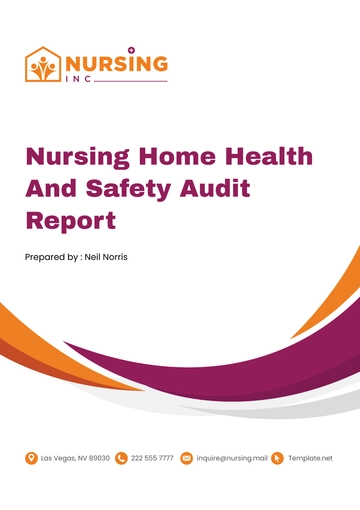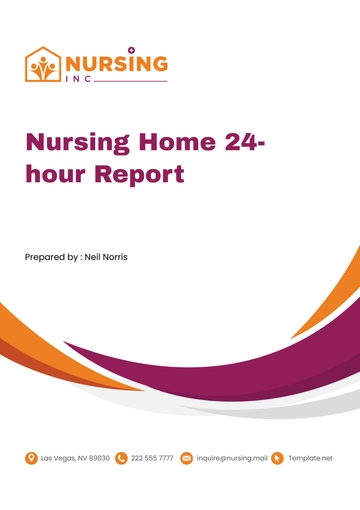Free Nursing Home Air Quality Monitoring Report

I. Introduction
In our ongoing commitment to ensuring the health and well-being of our residents, staff, and visitors, we have conducted a comprehensive Air Quality Monitoring Report. The primary objective of this report is to assess the indoor air quality (IAQ) across various locations within our facility, including resident rooms, common areas, and any specific areas of concern identified by our staff or through previous assessments. By systematically evaluating the air quality, we aim to identify potential issues, implement corrective actions, and maintain an environment that supports the health of all individuals in our facility.
II. Background Information
Our facility is a modern, medium-sized nursing home designed to provide a comfortable and healthy living environment for up to 100 residents. It features a combination of individual rooms and shared spaces, including dining areas, lounges, and activity rooms, all equipped with HVAC systems to regulate temperature and airflow. Despite our efforts to maintain high standards of cleanliness and ventilation, potential air quality issues could arise from several sources. These include the use of cleaning chemicals, emissions from furniture or building materials, and external pollution sources due to our location near a busy urban area. Recognizing these potential challenges, we are proactive in monitoring and improving our air quality to ensure the well-being of everyone in our care.
III. Monitoring Methodology
A. Equipment Used
For our air quality monitoring, we utilized state-of-the-art equipment, including particulate sensors, volatile organic compound (VOC) meters, carbon dioxide (CO2) detectors, and humidity and temperature gauges. Each piece of equipment was carefully selected for its accuracy and reliability in detecting specific air quality parameters. Prior to the commencement of the monitoring period, all equipment underwent a rigorous calibration process to ensure the integrity and precision of our data collection.
B. Sampling Locations
The sampling locations were strategically chosen to provide a comprehensive overview of the air quality throughout our facility. These included high-traffic common areas, such as dining halls and lounges, resident rooms, and areas with potential for higher levels of pollutants like laundry rooms and storage areas for cleaning supplies. The selection aimed to encompass a variety of spaces to accurately assess the overall air quality and identify any areas requiring attention.
C. Sampling Frequency
To capture a representative snapshot of our facility's air quality, sampling was conducted on a weekly basis over a three-month period. This frequency allowed us to account for variations in air quality at different times and under various conditions, such as changes in facility occupancy and outdoor air quality. Special attention was given to sampling during different times of the day to assess the effectiveness of our ventilation system throughout the facility's operational hours.
IV. Air Quality Standards
In conducting our air quality monitoring, we adhered to a set of rigorous standards defined by U.S. regulatory bodies to ensure the health and safety of our residents and staff. These standards serve as benchmarks for acceptable air quality levels within our facility.
EPA's National Ambient Air Quality Standards (NAAQS)
ASHRAE Standard 62.1: Ventilation for Acceptable Indoor Air Quality
OSHA Regulations
V. Benchmarks
To evaluate our air quality against recognized health and safety thresholds, we established benchmarks based on the aforementioned standards. The following table outlines the acceptable levels for various air quality parameters within our facility.
Air Quality Parameter | Acceptable Level |
Particulate Matter (PM2.5) | < 12 µg/m^3 |
Total Volatile Organic Compounds (TVOCs) | < 500 µg/m^3 |
Carbon Dioxide (CO2) | < 1000 ppm |
Relative Humidity | 30-60% |
Temperature | 68-78°F (20-25°C) |
V. Results and Findings
The data collected from our comprehensive air quality monitoring campaign has been meticulously analyzed, comparing the measured values of various air quality parameters against the established benchmarks. This comparison is crucial for identifying areas where our facility's air quality meets the expected standards and areas requiring improvement.
Air Quality Parameter | Measured Value | Benchmark | Compliance |
Particulate Matter (PM2.5) | 10 µg/m^3 | < 12 µg/m^3 | Yes |
Total Volatile Organic Compounds (TVOCs) | 480 µg/m^3 | < 500 µg/m^3 | Yes |
Carbon Dioxide (CO2) | 1050 ppm | < 1000 ppm | No |
Relative Humidity | 55% | 30-60% | Yes |
Temperature | 75°F (24°C) | 68-78°F (20-25°C) | Yes |
The analysis of the collected data reveals that, for the most part, our facility's air quality aligns with the established benchmarks, indicating a healthy indoor environment. Parameters such as PM2.5, TVOCs, relative humidity, and temperature all fall within acceptable levels, showcasing the effectiveness of our existing air quality management strategies.
However, the measured levels of CO2 exceeded the benchmark, indicating areas of our facility may not have adequate ventilation, particularly in high-occupancy areas or spaces with limited natural airflow. This finding underscores the need for targeted improvements in our ventilation system to ensure that CO2 levels are consistently maintained below the 1000 ppm threshold, enhancing the overall air quality and safety for our residents and staff.
VI. Recommendations
Based on the findings of our air quality monitoring, we propose the following recommendations to address the identified issues and to continue to uphold and improve the indoor air quality within our facility:
Enhance Ventilation: Increase ventilation in areas where elevated CO2 levels were observed. This may involve adjusting HVAC settings, installing additional air intakes, or incorporating air purifiers with CO2 reduction capabilities.
Regular Maintenance: Continue regular maintenance and inspection of the HVAC system to ensure optimal performance and air filtration, focusing on areas with high occupancy or limited natural airflow.
Monitoring Program: Implement a continuous air quality monitoring program to promptly identify and address any deviations from the benchmarks, ensuring ongoing compliance and adjustment of strategies as needed.
Staff Training: Conduct additional training for facility staff on maintaining air quality, including proper use of cleaning chemicals and management of potential pollution sources.
Resident Awareness: Increase awareness among residents and visitors about the importance of good air quality practices, such as avoiding smoking in non-designated areas and minimizing the use of personal fragrances or other potential VOC sources.
These steps are designed to not only address the current findings but also to establish a proactive approach to maintaining and improving air quality, safeguarding the health and comfort of all occupants of our facility.
VII. Conclusion
The comprehensive air quality monitoring conducted within our facility has provided valuable insights into the current state of our indoor air environment. By closely analyzing the data against established benchmarks, we have identified both our strengths in maintaining a healthy indoor atmosphere and areas where targeted improvements are necessary. Our commitment to implementing the recommendations outlined in this report demonstrates our ongoing dedication to providing a safe, healthy living and working environment for our residents, staff, and visitors. We recognize the importance of continuous monitoring and adaptation of our air quality management practices to meet the evolving needs of our community and to adhere to the highest standards of health and safety.
- 100% Customizable, free editor
- Access 1 Million+ Templates, photo’s & graphics
- Download or share as a template
- Click and replace photos, graphics, text, backgrounds
- Resize, crop, AI write & more
- Access advanced editor
Maintain optimal air quality with the Nursing Home Air Quality Monitoring Report Template from Template.net. This vital document is both editable and customizable, enabling you to accurately track and report air quality levels. Adapt the template to fit your monitoring protocols, with ease of editing in our AI Editor tool, ensuring a clean and safe environment for residents and staff.
You may also like
- Sales Report
- Daily Report
- Project Report
- Business Report
- Weekly Report
- Incident Report
- Annual Report
- Report Layout
- Report Design
- Progress Report
- Marketing Report
- Company Report
- Monthly Report
- Audit Report
- Status Report
- School Report
- Reports Hr
- Management Report
- Project Status Report
- Handover Report
- Health And Safety Report
- Restaurant Report
- Construction Report
- Research Report
- Evaluation Report
- Investigation Report
- Employee Report
- Advertising Report
- Weekly Status Report
- Project Management Report
- Finance Report
- Service Report
- Technical Report
- Meeting Report
- Quarterly Report
- Inspection Report
- Medical Report
- Test Report
- Summary Report
- Inventory Report
- Valuation Report
- Operations Report
- Payroll Report
- Training Report
- Job Report
- Case Report
- Performance Report
- Board Report
- Internal Audit Report
- Student Report
- Monthly Management Report
- Small Business Report
- Accident Report
- Call Center Report
- Activity Report
- IT and Software Report
- Internship Report
- Visit Report
- Product Report
- Book Report
- Property Report
- Recruitment Report
- University Report
- Event Report
- SEO Report
- Conference Report
- Narrative Report
- Nursing Home Report
- Preschool Report
- Call Report
- Customer Report
- Employee Incident Report
- Accomplishment Report
- Social Media Report
- Work From Home Report
- Security Report
- Damage Report
- Quality Report
- Internal Report
- Nurse Report
- Real Estate Report
- Hotel Report
- Equipment Report
- Credit Report
- Field Report
- Non Profit Report
- Maintenance Report
- News Report
- Survey Report
- Executive Report
- Law Firm Report
- Advertising Agency Report
- Interior Design Report
- Travel Agency Report
- Stock Report
- Salon Report
- Bug Report
- Workplace Report
- Action Report
- Investor Report
- Cleaning Services Report
- Consulting Report
- Freelancer Report
- Site Visit Report
- Trip Report
- Classroom Observation Report
- Vehicle Report
- Final Report
- Software Report





























